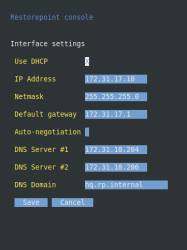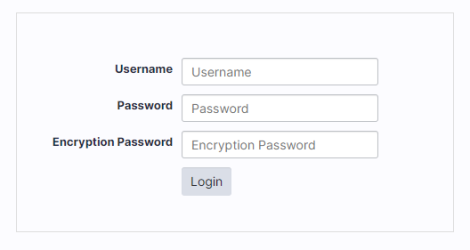Restorepoint is available as a hardware appliance or a VMware virtual appliance. This section describes how to perform the initial configuration of your Restorepoint appliance and configure it to communicate with other devices on your network.
Before You Begin
Before you install your Restorepoint appliance, ensure you meet the following requirements:
-
For hardware installations, 1U of rack space available to install the appliance, with a standard 240V power socket
-
For hardware installations, allocate a port on your Ethernet switch for the appliance
-
The appliance has an allocated static IP address
-
You have configured your firewall to allow traffic between the appliance, and the network devices and servers that Restorepoint will control
-
For virtual deployments, verify that you are running VMware ESX vSphere 4 or above and
-
For virtual deployments, verify your ESX host has 4 GB RAM available and the datastore where the virtual machine will be deployed has 256 GB available
-
Configure your firewall to allow outbound traffic from Restorepoint to the Internet. If you have a firewall between any of your devices and Restorepoint, you may need to open additional ports. For more information, see device-specific details in the Plugin Guide (Help > Plugin Guide).
-
Configure your mail server to allow Restorepoint to relay email
Firewall Requirements
This section lists the ports used to by clients connecting to Restorepoint and the ports used by Restorepoint to connect to network devices and other servers.
Your firewall policy might need to be modified for Restorepoint to function correctly.
Traffic from Clients to Restorepoint
The following table lists traffic from Restorepoint to network devices:
|
Port |
Purpose |
|---|---|
|
443/tcp |
Restorepoint user interface |
|
22/tcp |
Restorepoint shell access |
|
161/udp |
(optional) SNMP monitoring |
Traffic from Restorepoint to Network Devices
Restorepoint connects to network devices in a variety of ways, depending on the vendor. Sometimes, devices use back-connections to transfer their configuration to Restorepoint. See the device-specific details in the Plugin Guide (Help > Plugin Guide).
Other Traffic Originating from Restorepoint
The following table lists outbound firewall requirements:
|
Port |
Purpose |
|---|---|
|
443/tcp |
Download updates from Restorepoint update servers, and HA database sync |
|
53/udp |
Lookup to DNS servers |
|
25/tcp |
Send notification emails using SMTP |
|
123/udp |
Time synchronization with NTP servers (optional) |
|
22/tcp |
Initiate remote support requests, or communicate with an Agent’s master (optional) |
Browser requirements
Restorepoint requires a modern browser with JavaScript enabled. Restorepoint has been tested with the following:
- Chrome (v35)
- Firefox (v25)
- Internet Explorer 10
- Safari (v6)
- Opera (v12.10)
Restorepoint Virtual Appliance
The Restorepoint Virtual Appliance can be downloaded as a ZIP archive from the Restorepoint website. The following steps refer to VMware vSphere 4.0.
- Expand the Restorepoint ZIP file in a suitable location on your PC.
- Launch the vSphere Client.
- Right-click on the desired destination in the left-hand column and choose Deploy OVF Template, select Deploy from file and browse to the OVF file inside the extracted folder.
- Select all the files in the folder. There should be a mf file, an ovf file, and 2 vmdk files.
- Click Next.
- Click Next.
- Use the default name or enter a name for the virtual machine and the inventory location, then click Next.
- Choose the host or cluster, then click Next.
- Select which datastore should be used, then click Next.
- Choose Network Mapping, then click Next.
- Check the summary information, then click Finish.
- The virtual machine will now deploy. After completion, click Close in the completion dialog box.
IP Address Setup
To set up Restorepoint, you must configure the network parameters, which include the static IP address you have allocated to the appliance, and the DNS and gateway settings for your network. Follow these steps:
-
Connect a monitor and keyboard to suitable ports on the rear panel of the appliance, or open the virtual machine console in the Virtual Infrastructure client.
-
At the login prompt, typed the default user name (admin) and password (admin) for the device and then choose option 1 on the console menu:
-
Type the IP address, Netmask, default gateway, and primary DNS server as prompted. The DNS server must be able to resolve public names (for example, support.restorepoint.com), otherwise the appliance cannot retrieve software updates.
-
Enter y to confirm the settings. If the settings are applied successfully, the console menu will be redisplayed. You can exit now.
You can disconnect your monitor and keyboard. To continue the initial setup, open a browser window on a network connected PC and enter the IP address you set for the appliance in the URL bar.
Alternative Method for Setting the IP Address
You can also connect to the Restorepoint appliance for initial setup over a network using the factory-configured default IP address/netmask (192.168.1.1/255.255.255.0), if these settings do not conflict with any devices already on your network. Use a browser to connect to https://192.168.1.1 and set the IP address as shown above.
If these settings are in use on your network, you may connect the device directly to a PC using an Ethernet cross-over cable. Configure your PC to use an address in the 192.168.1.2 - 254 range, then use a browser to connect to https://192.168.1.1.
Connecting to Restorepoint for the First Time
After you set the IP address for Restorepoint, use a browser on a network-connected PC to connect to the IP address and complete the initial configuration.
Restorepoint initially uses a self-signed certificate. Because of this, your web browser will warn you of an invalid (untrusted) certificate. This is normal behavior because the appliance certificate is not signed by a Trusted Certificate Authority. The session will still be encrypted. Refer to your browser instructions on how to proceed and accept the unsigned certificate. A valid (signed) certificate can be uploaded to Restorepoint after the initial configuration is completed.
To connect to Restorepoint for the first time:
- Log in with the default username (admin) and default password (admin). Restorepoint displays the End-User License Agreement.
- Read the terms of the Agreement, then click I Accept to signify that you accept the Agreement. You will not be able to use Restorepoint if you do not accept the Agreement.
- Enter your company details, then click Next.
- Confirm the network configuration and the SMTP details. If Restorepoint is not connected to the Internet, select the relevant box. Click Next.
- If Restorepoint needs a proxy to connect to the Internet, or needs additional static routes to connect to your network devices, enter the details on page 4. Click Next.
- Enter the details for the first administrator. You must change the default administrator password and encryption password; these cannot be identical, and must be at least 8 characters long. You will also need to enter your email address and a password recovery question and answer, which can be used to reset your password. It is important to choose a question that only you know the answer. Restorepoint will send you a password recovery token by email. See the Recovery Procedure for more information. Click Next.
- Click Install. Restorepoint will contact the update servers to verify the license and download the device plugins. To allow this, ensure that your firewall allows the required traffic ( for more information, see Firewall Requirements).
Connecting to Restorepoint After a Reboot
When Restorepoint is rebooted, it will start in a locked state. It is not able to perform any operations until the encryption password is entered, and only admin-level operators can log in to the appliance.
To enter the encryption password, use a browser to connect to the appliance and provide your administrator credentials and the encryption password:
The appliance will then transition to the normal operation mode, and subsequent administrator logins will not require an encryption password.

